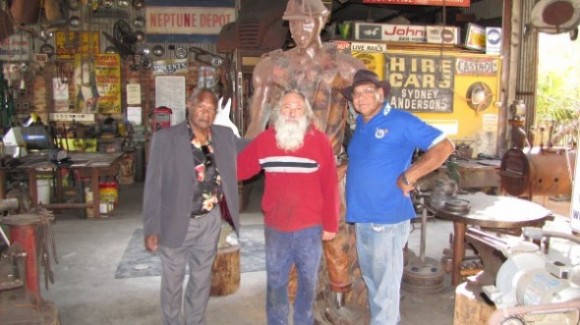It is the stuff of legend.
In the red dust and heat of Western Australia’s Pilbara region, on the other side of the continent to their homelands and seas, a gang of Torres Strait Islanders didn’t just break the record time for railway track-laying.
They obliterated it.
Sinking 7km of track in just 11 hours and 40 minutes, the proud Islanders set a world record that has not been bettered since that warm day in May, 1968. The first carriages of iron ore began rolling out to Port Hedland along the 500km of track in July that year, along a line that has been the backbone of Australian economic development to this day.
And now, deadly MC John Whop says the time has come for the contribution of his people in the Pilbara to be recognised.
Known to radio land as “Uncle John” and to Torres Strait Islanders “Awa John”, Mr Whop said a statue in honour of the rail gang will be unveiled on September 22, in Port Hedland. And he is urging Islanders to make the trek west in honour of their forefathers’ hard work, their hard zagedt.
“There is a national and international focus on a group of menfolks that made history,” he said.
“This is another milestone achievement and from the Torres Strait Islanders to boost Australia’s economy.
“Like in the Torres Strait Light Infantry Battalion, pearling, trochus and cane-cutting, Torres Strait Islanders and their families did it again – this time it was the laying of a railway track in a record time that hasn’t been broken yet.”
Port Hedland Local George Pitt has been fighting for recognition for the track-laying teams for years.
Leaving the Torres Strait as a 17-year-old in 1967 with his uncle and aunt, Mr Pitt headed for Queensland to find work cutting cane.
“Living at home was hardship, we were still under the reserve status then, so we went south to find the basic social conditions,” Mr Pitt told the Telegraph News in Port Hedland.
When the iron ore boom hit in the ’60s, Torres Strait Islanders headed for the Pilbara in droves.
“It was hard work, laying, spiking, anchoring lines all day,” Mr Pitt said “You took note when people walked away. . . they came in with no muscle, they left with bloody muscle, it was raw man-power. You’d breakfast at 4am, then at 5am you’re out there working, work all day then back into camp at 7pm.”
Mr Pitt came to the region later, working on the Dampier-Tom Price line in 1974. For the past 12 years, he has been campaigning for a memorial statue at the Don Rhodes Mining Museum in Port Hedland. And soon, the stainless-steel sculpture by artist Antonio Battistessa will stand testament to these proud Islanders’ work.
But Mr Pitt’s own work is not done, as the 62-year-old battles to raise funds to bring the few remaining railway workers over for the opening ceremony.
“It’s my cultural obligation to my people, especially those old fellers; there’s about 15 of them left now and they will see the statue and he’ll belong to all of them,” he said.
“We just want to fly a few of our people over to see what they created. All these people, indigenous people, were at the forefront of infrastructure development in the early days of Australia.”
From his role as Deadly Master of Ceremonies for Thursday Island NAIDOC, Mabo Day and July 1 Coming of the Light celebrations, Mr Whop, a popular radio personality, has joined with The Torres News to promote the unveiling of the statue in a tribute to the track-laying mobs.
“It was their strong work ethics and communal cultural strength that bound them together,” Mr Whop said.
“Some of them are not with us today. Their contribution gives us the pride to say eso, thank you from their parents, relatives, friends and mates.”
Awa John Whop is urging Torres Strait families to join in the celebrations.
“I am asking for families to yarn the stories and sing the songs of our loved ones of that time,” Mr Whop said.
And he is asking for Torres Strait Islanders to make the effort to travel to Port Hedland to attend the September 22 celebrations.
“I am sure there are dancers, singers and people to show, tell and share stories,” he said.
Mr Pitt said the statue might finally bring his people the recognition they deserved.
“You see how big that track is? Five hundred kilometres here to Newman. My mob did it in nine months. We did that.”



